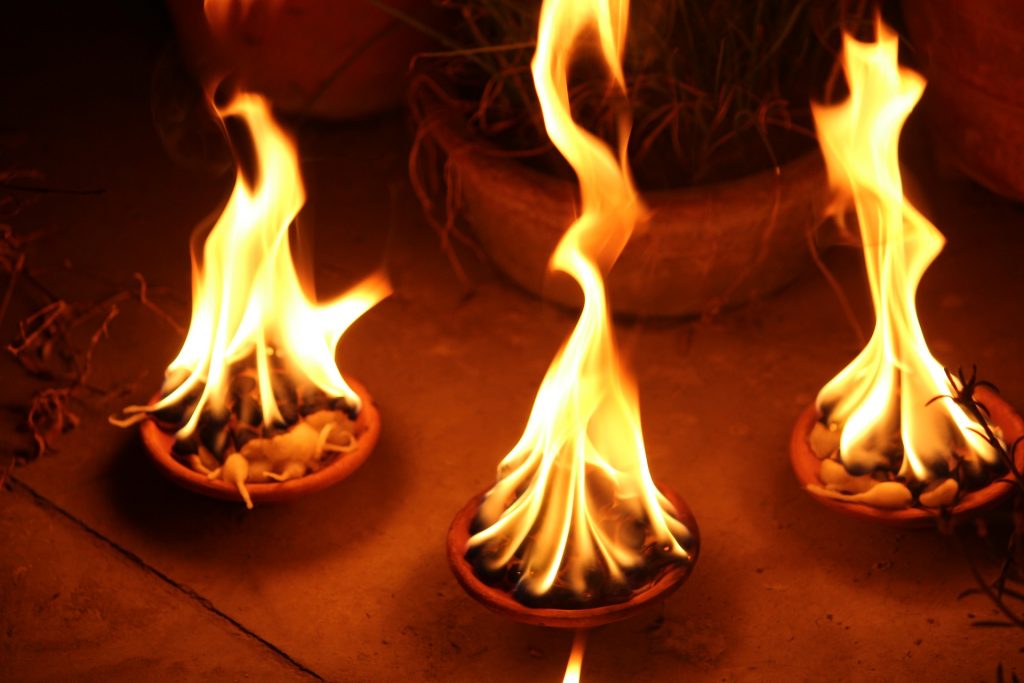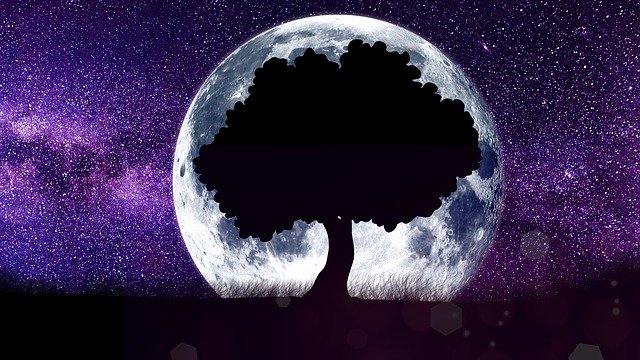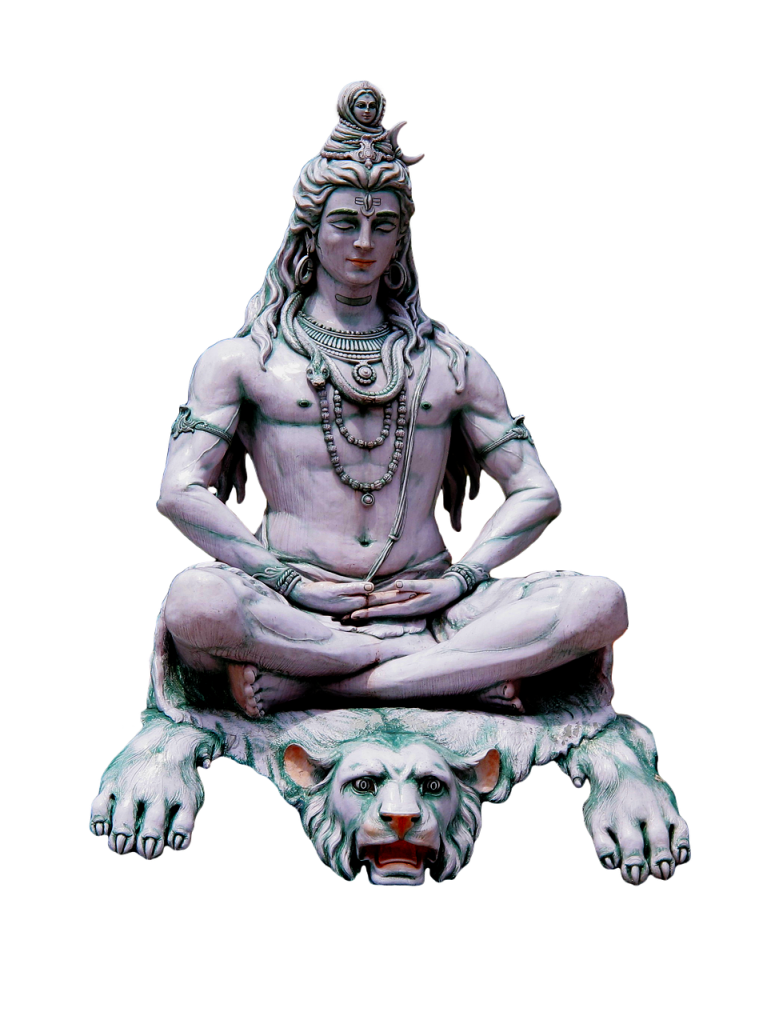Introduction to Vedic Astrology (Jyotish)

Welcome to this introductory article on Vedic astrology. I have written it for everyone who likes to get familiar with some of the basic unique features of Vedic astrology.
Therefore, it is mostly interesting for those that want to book a Vedic astrology reading or those that are familiar with other types of astrology.
If you would like to know how I prepare a chart reading, please read this other article on some basics in Vedic chart analysis.
The full article has an average reading time of about 9 minutes, but you may also jump ahead to the main headers in the text:
- Future predictions vs living in the present moment
- Difference between Western and Vedic astrology
- Understanding our mind with constellations beyond the signs (nakshatras).
- Tune into the moment by knowing your time periods (dasas).
- Zoom into specific areas of your life with detailed divisional charts.
- The role of astrology in guiding decisions.
- Vedic astrology as a spiritual practice.
- Examples of positive qualities of planets to enhance
- Examples of negative tendencies of planets to transcend.
- Types of remedies in Vedic astrology.
Vedic astrology in general
Vedic astrology is an ancient science and spiritual practice from India. Its most profound power lies in helping us to tune into our highest potentials. The emphasize is often on predicting past, present and future. However, further below, I share how my way of using Vedic astrology is focussed on bringing our attention to the present moment.
In most of the history of humankind the bright sky at night was not disturbed by artificial light. Therefore, the movement of celestial bodies were naturally very much part of daily life.
A lot of today’s science is based on repeatedly observed patterns in cause and effect. Similarly, most ancient civilizations studied patterns between the movement of celestial bodies and happenings on planet earth.
However, Vedic astrology is beyond this comparison with modern science. It is also called the ‘eye’ of the Vedas and thus a spiritual teaching. Hence, it can be seen as a guide towards the different goals of life which all culminate in final liberation (Moksha)[1]https://srigaruda.com/what-is-vedic-astrology/.
In its earliest and original sources, Vedic astrology is called ‘Jyotish’ which means ‘light’ in the Sanskrit language. Jyotish is one of the six limbs of the Vedic sciences, also called vedangas.
Though many contemporary astrologers focus primarily on interpretive principles of astrological charts (Horā), the term Jyotish officially also includes:
- Mathematics and astronomy (also called Gaṇita),
- Foreboding, palmistry and understanding of celestial and geographical events (also called Saṁhita).

In India, the Rishis[2]There are 18 ‘primary seers associated with the earliest sources of Jyotish: Sūrya, Kaśyapa, Vaśiṣṭha, Parāśara, Vyāsa, Pitamaha, Manu, Nārada, Marici, Atri, Añgirāsa, Garga, … Continue reading ~ seers of ancient times ~ have brought astrology to divine heights and their legisly is still being shared today. The same seers are also the original sources of large parts of the Vedas, Purāṇas and Vedāntic scriptures.
Future predictions vs living in the present moment
Astrology is often associated with methods to predict future events and personalities. This is an interesting contrast with some other teachings in Indian spirituality, like to live in the present moment or transcending the personality.
However, in my way of using astrology these future and personality predictions are not the goal itself but more an aid. On the contrary, astrology can help us to be fully focussed on the present moment.
We can ascertain our decisions much better by getting a good sense of our personality patterns and about what is to come in the future. In this line, astrology can help us to go beyond our doubts and focus our attention fully to the tasks in the present moment.
The present moment is the only thing that is a little bit in our control. In this sense it is all we can rely truly on. If we manage to focus all our attention to the tasks of the moment, our actions gain strength.
However, if we continue to entertain doubt about our personality and our future, we lose this potential. In Vedic astrology we are given a clear structure of how to see our past, future and personality for what they are. This enables us to learn approaching these fields of life from our attention in the present. Hence, these facets of astrology can be a great help in practices like mindfulness and meditation.
Difference between Western and Vedic Astrology
I am not an expert in Western astrology. My interest in astrology was aroused in India, where Vedic astrologers managed to mention things about my life that they could not have just guessed.
A main difference between Western and Vedic astrology is that Western astrology is using a fixed zodiac, where planet earth is seen as the the centre. This is also called the tropical zodiac and based on the position of the Sun, which rotates all signs each year.
Similarly, in Vedic astrology, the Sun is also seen as the center and all planets are revolving around it. It is, however, acknowledged that the axis of the earth also rotates very slowly. For this reason, Vedic astrology has taken the star Chitra as reference point to measure the rotation time of the earth around the Sun (which is a so-called year).
This rotation happens to be approximately 20 minutes longer than in the calculations in the Western system. For this reason the Vedic or ‘Sidereal’ zodiac now differs 25 degrees from the Western way of depicting the zodiac and signs (about 2000 years ago they were the same). In this sense, Western astrology is based on the solar calendar and Vedic astrology corresponds to the original signs.
Here below you can read more on how the Vedic system excels and shines its light to illuminate our lives in very unique ways.
Indian spirituality, energetic powers and ancient sages
In many ancient cultures the planets and constellations were referred to as divine and energetic powers. In Vedic Astrology, these perspectives have been preserved beautifully and are still very much alive in daily life.
All planets and signs are related to mantra sounds, deities, professions, foods, mythology, colours, behavioural qualities and saints and sages. Under the section about remedies at the end of this page, you can read more about how this knowledge is still applied in spiritual practices.
Understanding our mind with constellations beyond the signs (Nakshatras)
Vedic astrology is known for its amazing capacity to tune into details that can make a difference in someone’s life. Just like Western astrology it works with planets, signs and house placements.
However, beyond the 12 zodiac signs Vedic Astrology expounds on constellations known as nakshatras. There are 27 or 28 nakshatras[3]Here it has to be noted that there exist both a 27 and a 28 scheme of nakshatras. In the 28 scheme, the nakshatra Abhijit is added. The same name is used to define the exact time of midday and … Continue reading and these are divided again into 4 parts each. This detailed division helps in explaining how people that are born on similar times still can have such a different mindset.
The placement of the Moon represents our mind in Vedic astrology. As the Moon transits all these nakshatras, a large variety of individual mindsets are created. Therefore, the Moon’s nakshatra in a birth chart is of immense importance for how we are experiencing the world.

The nakshatras represent the deeper layers of our being and are used in various ways to fine-tune the insights generated by astrologers.
The role of ruling planets of the signs is often referred as a parental one, while the nakshatra’s role is often compared to the grandparents. In this sense, they are often less bound by circumstances, but can still be very decisive in their unique ways in relating to the individual mind.
Tune into the moment by knowing your time periods (dasas).
Based on these nakshatras, Vedic astrology has developed several detailed ‘dasa’ or time period systems. These are periods of time in which certain planets become more active. These activations can manifest within our own selves as, for example, feelings or perceptions. Other types of planetary dasa activations can show up in more outer circumstances, like in the people we meet.
Through assessing these dasa systems, we can see which planetary energies are active and how different areas of life get affected. This gives a great sense of what kind of energetic powers are at work in our life, and of course about what lies ahead in the future.
By tuning into these ‘dasas’, Vedic astrologers can advice certain spiritual practices that help aligning our actions with these cosmic forces.
Zoom into specific areas of your life with detailed divisional charts.
Vedic astrology provides tools to tune into very detailed areas of life through the so-called divisional charts. These charts are like close-up horoscopes of certain parts of the birth chart and reveal details about certain areas of life.
They expound on areas as career, married life, study, wealth, but also on more inner tendencies towards diseases, strength to overcome these, karma passed on by the parents, one’s own previous lives and spiritual tendencies.
For correct interpretations of these subcharts it is important to ascertain the precise birth time. As this time is often not recorded entirely accurately, there exist various techniques to estimate a more precise time than is given by parents, hospital or municipality. This can be a bit of a time-consuming task though.
However, if one is eager to know the details of these areas of life, this fine-tuning of the birth time is crucial. Nevertheless, also without a precise time, Vedic astrology provides an abundance of insights, effective counseling and remedies.
Indian Astrology: spiritual guidance for Self-realisation
How different life goals can merge into one-pointed action.
Indian culture has been evolved all around the goal of Self-realisation and so has the Indian Astrology. Though it also shines its light on a wide variety of areas of life, its deepest core always reminds us of this final goal of life.
Whether, we wish to achieve wealth (artha), pleasure (kama) or righteousness (dharma), in the larger context of Vedic Astrology the final goal is always moksha (liberation).
Seen in this way, Vedic Astrology helps us to use every experience as a stepping stone towards Self-realisation. Whether the focus is on desires, achievements or failures, Jyotish shines its light on every situation, regardless whether it is pleasurable or painful.
Every experience is teaching us a lesson and is ‘tickling’ us to transcend our experiencing to our highest potential. Whenever this is seen clearly, we can be gratefully accepting and transcending every situation in life. And so learn to take most out of every moment in life.
The power of this astrology lies in shining the light of clarity on all experiences and desires, while rejecting none of them.
The role of astrology in guiding decisions
Jyotish has an enormous power to provide guidance in decision-making processes. However, we can’t escape the fact that we always still have to tune into the flow of our own life to come to the final decisions ourselves.
Through its predictive power in events, an astrologer can assess whether certain directions in life will lead to more auspicious or less auspicious outcomes. This is its core value in guiding decision-making processes.
Additionally, Vedic astrology has been developed to shine light on someone’s individual dharma (righteousness) in the different fields of life like wealth (artha), pleasure (kama) and liberation (moksha).
Vedic astrology shines its light on different areas of life
The main aim of Jyotish to guide us so that our talents start blooming and our weaknesses are getting transcended. By shining its light on every aspect of life, Jyotish has the potential to purify our vision on life so that we can take the right perspectives in life.
If you are unhappy, a first step to transformation is often to take on another perspective on your life.
Sometimes, the answers are very simple. For example, if Mars is creating challenges in a horoscope, it can well be that one has to experience some past-life karma of having caused pain to other people in some violent ways. Therefore, now the time has come to experience the results of these actions. We may feel that people do not respect our boundaries and even violate them in some sense.
By acknowledging these ancient mistakes that we have made, acceptance can become much more easier. The challenging experiences are only meant for us to learn.
Through these experiences, we can allow ourselves to be moulded into more divine forms. This moulding and transformation often happens in the depths of our inner-being where our conscious minds mostly does not reach. Further below, I elaborate on how remedial practices can reach these depths and help.
By following this guidance we can avoid feeling stuck in less fruitful mindsets. Te remedies prescribed can really help to accelerate our processes to express and experience our divine nature in life.
Remedies in Vedic Astrology
Vedic Astrology as a spiritual practice

There are many types of remedies in Vedic astrology. When these are applied with the right attitude, they can become very potent spiritual practices.
These remedies can help tuning one’s energy towards the main goals in life. And as soon as our actions and thoughts form a strong one-pointed flow towards a goal, they gain power.
The goal of life is the same for most human beings and lies in finding freedom and happiness. However, in our ancient past, we have had many different projections on how to achieve these goals in life.
In this lifetime we may might want to neutralize some of these ancient endeavours that we have started, while other could be stimulated.
For example, if someone has tried hard but failed to pursue a powerful political position in a previous life, this energy may still life forth today. Therefore it may remain a tense and charged area in this present lifetime. This could be seen in a horoscope by the placements of Sun, Rahu and/or Mars.
Similarly, if someone has performed certain spiritual practices in a previous lifetime, these actions live forth within the energetic vibration of the individual.
Indian religions have expounded on different concepts to define these circumstances, like karma (results of one’s actions) or dharma (righteous actions to be taken).
Though many people are familiar with the general meaning of these concepts, their applications in daily life is often less straightforward. The power of Vedic astrology lies in providing individual answers to these quests.
In practice this means that every chart and life problem can be aided by certain spiritual practices (also called remedies). These are based on divine connections and qualities of every planet, sign and constellation.
These remedies can be particular mantras, wearing of gemstones, focussing on the qualities of saints and sages, doing certain meditations, rituals or applying particular uplifting principles in life.
It is important to always remember that these remedies are not bound to one set of religion or spiritual perspective. For example, if a horoscope indicates specific benefits of association with the divine mother, a Christian may focus on Virgin Mary, a Muslim on Fatima and those with a Hindu faith on Devi. Like this all planets can be connected to Christian angels as well[4]For details regarding the connections between planets and angels in Christianity, see this book of one of the most famous Western astrologers: William Lilly.
Every planet has ‘higher’ and ‘lower’ qualities, which come forth differently in every horoscope. By doing the right practices, we can transcend lower tendencies and strengthen higher tendencies. Eventually this will make us channel our highest potentials in life.
In this sense, Vedic astrology is a great guide to fine-tune our spiritual practices.
Some examples of positive qualities of planets to enhance:
- Self knowledge, leadership and good governance (Sun),
- Love and artistic expression (Venus)
- Unconditional love, empathy and compassion (Moon)
- Skills and communication (Mercury),
- Strength and courage (Mars),
- Discipline and structure (Saturn),
- Wisdom and Knowledge (Jupiter),
- Self-realisation (Ketu),
- Endeavouring and experiencing in world of illusion Maya (Rahu).
Remedies can help increasing these positive traits, while they transcend the more negative qualities of the planets.
Examples of negative tendencies of planets to transcend:
- Arrogance and negative use of power in leadership (Sun),
- Overindulgent and feelings like lust (Venus),
- Over-emotional (Moon),
- Clumsiness or harsh and miscommunications (Mercury),
- Aggression and (territorial) possessiveness (Mars),
- Whining about suffering and lack of discipline (Saturn),
- Rigidness and orthodox believe structures (Jupiter),
- Neglecting one’s duties or appearance (Ketu),
- Being overambitious or overindulging (Rahu).
Types of Remedies in Vedic Astrology

Of course, observing and acknowledging our own flaws and strengths is already a first step to transformation! With a good dose of will power we can overcome many negativities and obstacles.
However, certain stronger tendencies may cause more struggle and delay. This simply means that these stagnant energies have taken root on some deeper level.
These deeper-rooted tendencies are often called vāsanās in the Indian tradition. For these, Vedic astrology can tune into individual circumstances to find the most efficient spiritual practices, which then can be applied as remedial measures. Some of these practices are very well known like lightning a candle, chanting certain mantras or giving specific donations.
- In an another article on this website I elaborate in more depth on the different types of remedial measures, and on the importance of our subtle attitude while performing them.
- Or book an astrological reading to find out the best remedies for your individual horoscope.
~ May all beings be happy ~ Om Shanti Shanti Shanti ~
References
| ↑1 | https://srigaruda.com/what-is-vedic-astrology/ |
|---|---|
| ↑2 | There are 18 ‘primary seers associated with the earliest sources of Jyotish: Sūrya, Kaśyapa, Vaśiṣṭha, Parāśara, Vyāsa, Pitamaha, Manu, Nārada, Marici, Atri, Añgirāsa, Garga, Bhṛgu, Lomaśa, Chyavana, Śaunaka, Pauliśa and Yavana. see Visti Larsen’s website for more info. |
| ↑3 | Here it has to be noted that there exist both a 27 and a 28 scheme of nakshatras. In the 28 scheme, the nakshatra Abhijit is added. The same name is used to define the exact time of midday and because Capricorn is the natural sign of midday, Abhijit is placed in the middle of this sign. This 28 scheme is used for assessing more spiritual topics whereas the 27 scheme is used for more material ones |
| ↑4 | For details regarding the connections between planets and angels in Christianity, see this book of one of the most famous Western astrologers: William Lilly |